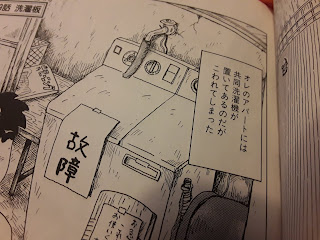Got some help from the FB group 日本語, understanding this panel from 大東京ビンボ―生活マニュアル. They say drop the -u at the end of a verb; replace with -a and add ず, and you have an old-fashioned but still used way of saying ないで ("don't" or "without...").
I tried all the different verb endings, both -ru and -iru/-eru, plus the two irregulars する and 来る, and Google Translate agrees they mean what's predicted. I'd say we're good.
食べらず。
買あず。帰らず。待たず。書かず。泳がず。死なず。飛ばず。飲まず。話さず。
来らず。しらず。
Fits 彼女's personality: she is competent and polite, and she's at a traditional event, so it makes sense she'd go a little retro in her speech.
Sunday, January 12, 2020
Friday, January 10, 2020
(Mostly) automated construction of Anki flashcards
So I have a new method, and it's not terrible. :)
Get the text in. If it's a web page, I cut and paste. If it's a printed page, I use the Google Translate app. (As you can see, it struggles sometimes, but it's better than digging it all out myself.)

 Put it in the Takoboto app. This picks out keywords. I select the ones and put them in a list.
Put it in the Takoboto app. This picks out keywords. I select the ones and put them in a list.
 Then I send that list to AnkiDroid. (Don't send each card -- the rest of this won't work.)
Then I send that list to AnkiDroid. (Don't send each card -- the rest of this won't work.)

Problem was that it gave me a card that either was English->Japanese; or if Japanese->English, shows the furigana on the front with the kanji. But I want to have to provide the pronunciation, so I want it on the back.
I went into Anki on the PC (it's too hard to edit on the tablet), Tools > Manage Note Types > jp.takoboto > Cards, made sure Japanese > English was selected, and edited appropriately (the cards are written in HTML).
It's working for now at least.

Get the text in. If it's a web page, I cut and paste. If it's a printed page, I use the Google Translate app. (As you can see, it struggles sometimes, but it's better than digging it all out myself.)




Problem was that it gave me a card that either was English->Japanese; or if Japanese->English, shows the furigana on the front with the kanji. But I want to have to provide the pronunciation, so I want it on the back.
I went into Anki on the PC (it's too hard to edit on the tablet), Tools > Manage Note Types > jp.takoboto > Cards, made sure Japanese > English was selected, and edited appropriately (the cards are written in HTML).
It's working for now at least.

私のレシピ:砂糖なしのきんぴら
材料
にんじん 2本
茸の出汁 1/2 杯分
酒 1 大さじ
醤油 1/2 大さじ
ごま油 1小さじ
米酢 1小さじ
作り方
にんじんを千切りになる。鍋の中に全部を入れる,弱火する、20分少くなくとも、にんじんが柔らかくまで。かんたんね!
にんじん 2本
茸の出汁 1/2 杯分
酒 1 大さじ
醤油 1/2 大さじ
ごま油 1小さじ
米酢 1小さじ
作り方
にんじんを千切りになる。鍋の中に全部を入れる,弱火する、20分少くなくとも、にんじんが柔らかくまで。かんたんね!